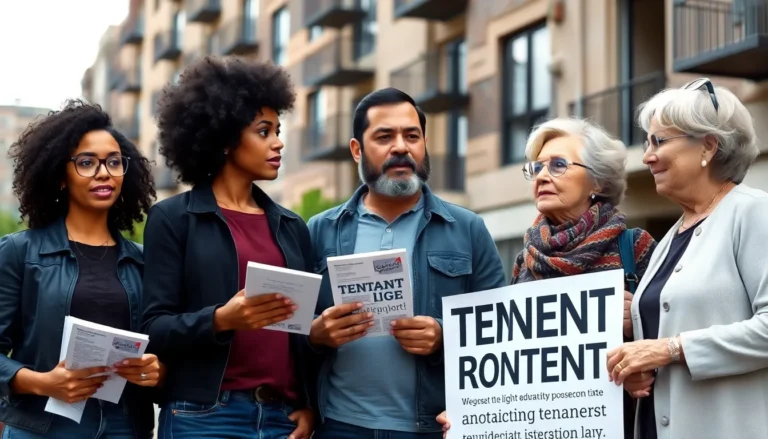Table of Contents
ToggleNavigating the world of rental agreements can feel like deciphering ancient hieroglyphics. For landlords, a well-crafted contract isn’t just a piece of paper; it’s the secret sauce that keeps everything running smoothly. It protects their investment and sets the stage for a harmonious landlord-tenant relationship. After all, nobody wants to be the landlord who ends up with a tenant who thinks “no pets” means “bring your entire zoo.”
But let’s face it, creating a landlord contract can be a daunting task. With legal jargon that could put a caffeine-fueled squirrel to sleep, it’s easy to feel overwhelmed. Fear not! This guide will break down the essentials of a solid landlord contract, making it as easy as pie—without the calories. So grab your favorite beverage and let’s dive into the nitty-gritty of landlord contracts that make life easier and keep those pesky misunderstandings at bay.
Understanding Landlord Contracts
Landlord contracts serve as crucial documents in the rental process. These agreements create a legal framework governing the relationship between landlords and tenants.
Definition of a Landlord Contract
A landlord contract, often referred to as a rental agreement or lease, outlines the terms and conditions for renting property. It specifies essential elements, such as rent amount, payment methods, lease duration, and rules regarding property maintenance. Parties involved must review and sign the contract to ensure mutual understanding of their rights and obligations. Many jurisdictions require these contracts to adhere to specific regulations, making clarity and precision critical for compliance.
Importance of Landlord Contracts
Landlord contracts play a vital role in protecting both parties’ interests. A well-structured contract minimizes the risk of disputes by clearly defining responsibilities and expectations. It establishes clear terms regarding rent payments, security deposits, and maintenance procedures. Additionally, such contracts can provide legal recourse in case of violations, ensuring landlords can enforce their rights effectively. Strong agreements also foster positive landlord-tenant relationships, promoting open communication and cooperation throughout the lease period.
Key Components of Landlord Contracts

Landlord contracts contain essential details that define the relationship between landlord and tenant. Understanding these components helps prevent disputes and ensures smooth operations.
Lease Terms and Conditions
Lease terms and conditions outline the duration of the rental agreement. Most contracts specify the start and end dates, typically ranging from one year to month-to-month arrangements. Clearly defined payment schedules set due dates for rent, frequently on a specific day each month. Late payment penalties often apply, reinforcing timely rent submission. Terms regarding property use, such as restrictions on pets or unauthorized alterations, maintain order within the property. Both parties acknowledge these conditions by signing the agreement.
Security Deposits and Fees
Security deposits protect landlords against potential damages or unpaid rent. Standard practice involves collecting one month’s rent as a security deposit, though local laws may dictate different amounts. Contracts should specify the timeline for returning the deposit after lease termination, often within 30 days. Maintenance of clear records on deductions from the deposit guarantees transparency. Additional fees, such as application fees or pet deposits, should also be included in the contract. This clarity minimizes disputes over financial responsibilities.
Maintenance Responsibilities
Maintenance responsibilities determine who handles repairs and upkeep during the lease. Generally, landlords cover major repairs, such as plumbing issues or structural integrity problems. Tenants are responsible for routine maintenance, including the upkeep of appliances and lawn care. Both parties should have clear understanding regarding reporting procedures for repair requests, ensuring prompt responses. Clearly defining responsibilities in the contract helps avoid misunderstandings about property condition obligations. Regular communication regarding maintenance fosters a positive landlord-tenant relationship.
Common Issues in Landlord Contracts
Landlord contracts often encounter various issues that can complicate the rental experience. Understanding these common problems helps both parties navigate the complexities of rental agreements.
Disputes Over Terms
Disputes over terms frequently arise from vague language or differing interpretations. Tenants may misunderstand rent payment timelines or deposit return conditions. For example, if a lease states “reasonable repairs” without further explanation, disagreements can occur regarding what constitutes reasonable. Both parties must clarify terms to prevent conflicts. Open communication aids in resolving ambiguities before they escalate. Creating a glossary of key terms in the lease can enhance mutual understanding.
Breach of Contract
Breach of contract situations can significantly impact landlord-tenant relationships. Failure to pay rent on time constitutes a breach, leading landlords to seek remedies. Tenants might also breach contracts by damaging property or violating lease rules. In such cases, it’s crucial for landlords to follow legal procedures. Documenting breaches with photographs or written notices helps support claims. Parties should review contracts for clear repercussions to minimize confusion on enforcement.
Eviction Process
The eviction process presents its own set of challenges, often leading to misunderstandings. Both parties must adhere to local laws and specific notice periods to initiate eviction. For instance, some jurisdictions require a written notice before filing for eviction. Landlords need to understand these legal requirements thoroughly to avoid invalid evictions. Tenants may dispute evictions if they perceive them as unjust. Resources, such as legal guides, can provide clarity for both sides about obligations and rights during evictions.
Tips for Drafting a Landlord Contract
Drafting a landlord contract requires attention to detail and effective communication. The following tips can guide landlords in creating comprehensive agreements.
Clarity and Precision
Clear language prevents misunderstandings. Each term in the contract must be defined to reduce ambiguity. For instance, specify the rent amount, payment schedule, and lease duration in straightforward terms. Avoid jargon that may confuse tenants. Define responsibilities concerning property maintenance explicitly, ensuring both parties understand their obligations. Using bullet points can help highlight important aspects. Regularly review and update the contract to reflect any changes or new laws affecting rental agreements.
Legal Considerations
Legal compliance safeguards interests. It’s crucial to understand local laws regarding rental agreements, including tenant rights and fair housing regulations. Research specific provisions that must be included, like security deposit rules and notice requirements for termination. Consult legal professionals when drafting complex clauses. Keep records of all communications and agreements for potential disputes. Ensure both parties sign and date the contract to confirm mutual understanding.
Utilizing Templates
Using templates streamlines the drafting process. Many organizations provide customizable rental agreement templates that cover essential components. Consider adapting a template to fit specific property and rental conditions. Templates serve as a solid foundation but require careful review to ensure all terms align with local regulations. Regularly update the template to reflect changes in laws or personal preferences. Employing a template can save time while maintaining professionalism in contract creation.
Crafting a solid landlord contract is vital for both landlords and tenants. It sets the stage for clear expectations and responsibilities while minimizing potential disputes. By focusing on clarity and precision in language landlords can create agreements that not only protect their investments but also promote healthy relationships with tenants. Regularly reviewing and updating contracts ensures compliance with changing laws and addresses any emerging issues. Utilizing customizable templates can simplify the process while maintaining legal integrity. With the right approach to rental agreements landlords can navigate the complexities of property management with confidence.








